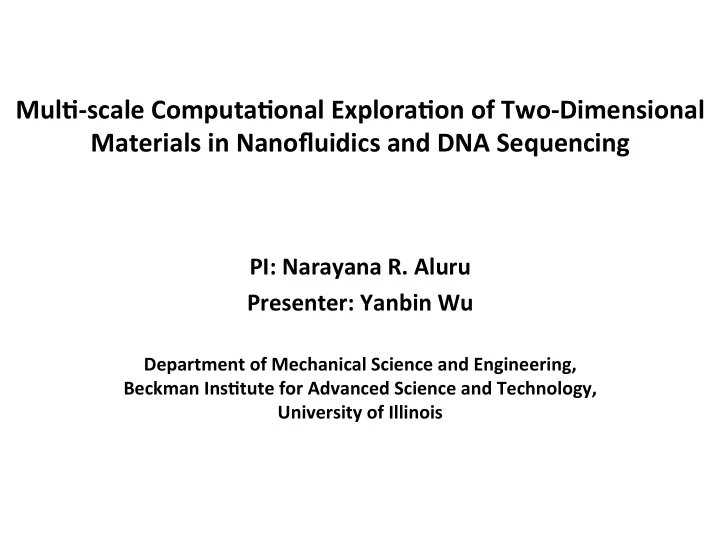

Mul$-‑scale ¡Computa$onal ¡Explora$on ¡of ¡Two-‑Dimensional ¡ Materials ¡in ¡Nanofluidics ¡and ¡DNA ¡Sequencing ¡ PI: ¡Narayana ¡R. ¡Aluru ¡ Presenter: ¡Yanbin ¡Wu ¡ ¡ Department ¡of ¡Mechanical ¡Science ¡and ¡Engineering, ¡ Beckman ¡Ins$tute ¡for ¡Advanced ¡Science ¡and ¡Technology, ¡ University ¡of ¡Illinois ¡
2D ¡Materials ¡in ¡Nanofluidics ¡and ¡DNA ¡Sequencing ¡ DNA base detection using nano-pore hBN-water interaction using quantum Monte Carlo Molybdenum disulfide mechanosensitive channel (MoS 2 ) Signal to noise ratio 5 Two distinguishable signals times better than including tension and ionic graphene current (ACS Nano 2014) (JPCL 2015)
hBN ¡based ¡Materials ¡ 1998 2008 1995 BNNT is noncytotoxic BNNT is thermally stable Applications in high-temperature Applications in biological probes and environment (Golberg group, Japan) biomaterials (Zettl group, Berkeley and Lawrence Berkeley National Lab, JACS 2009) hBN has >5 eV band-gap BNNT for harvesting “blue energy” Blasé group, Bocquet group, 1994 Nature 2013 Apply the hBN-based materials in nanofluidics and nano medicine.
We ¡Don’t ¡Know ¡How ¡Water ¡Interacts ¡with ¡hBN ¡ Experiments Simulations 5" 5" DFT*D" 4" 4" Frequency"(7mes)" Frequency"(7mes)" Combina7onal"rule" 3" 3" 2" 2" 1" 1" 0" 0" <10°" 30°*50°" 70°*90°" >120°" <10°" 30°*50°" 70°*90°" >120°" Contact"angle"(°)" Contact"angle"(°)" Challenging due to surface Lorentz-Berthelot combinational rule contamination, defects, different or DFT-D calculation fabrication methods Contact angle changes with time when exposed to air (Boinovich et al. 2013)
Solve ¡Many-‑body ¡Schrödinger ¡Equa$on ¡ ! ψ ( X ) = E ψ ( X ) ! = − ! 2 ^ ^ Target H ∇ 2 + V ≡ T H + V 2 m e 2 2 1 n N Z e 1 n e ^ X ( X , X ,..., X ) = V I ∑∑ ∑ = − + 1 2 n 4 r 4 r π ε π ε Diffuse Monte Carlo (DMC) i I i j 0 i I 0 < i j Isomorphism between Schrödinger equation and stochastic process Verify DMC method Wavefunction ↔ Distribution of walkers Kinetic ↔ Diffusion Potential ↔ birth/death The DMC method is verified and calibrated by comparing to couple cluster method with complete basis set (CBS) for a small system. Qwalk package is used. Example: harmonic oscillator
U$lizing ¡the ¡Power ¡of ¡Blue ¡Waters ¡ One hBN-water energy point cost 980,000 core hours. Scaling of Qwalk with number of processors Our simulation jobs that used to take weeks on other systems can now be done within days or even hours on Blue Waters.
Error ¡Control ¡in ¡DMC ¡ Finite Size Error Binding energies between a single water molecule and hBN monolayer: 76 ± 6 meV
Finding ¡an ¡Efficient ¡Method ¡Using ¡DMC ¡as ¡Reference ¡ Developing force field parameters needs Δ E for multiple configurations. DMC is computationally expensive: ~980,000 core hours for one data point. Use DMC to verify MP2 for one configuration. Then use MP2 to compute interaction energy of other configurations. For hBN, Δ E = -74 ± 7 meV Compared to -76 ± 6 meV by DMC
Develop ¡Parameters ¡by ¡FiWng ¡to ¡MP2 ¡Energies ¡ # & # 12 6 & 12 6 σ O-N 12 − σ O-N σ O-B 12 − σ O-B Δ E = ∑ 4 ε O-N ∑ 4 ε O-B + E vdWO-H + E ESP % ( % ( + 6 6 r r r r % ( % ( $ ' $ ' i ∈ {N} j ∈ {B} O- i O- i O- j O- j q B / q N ¡ ¡ σ N-‑OW ¡ ε N-‑OW ¡ ¡ σ B-‑OW ¡ ε B-‑OW ¡ ¡ (Å) ¡ (kcal/mol) ¡ (Å) ¡ (kcal/mol) ¡ ±0.30 ¡ 3.398 ¡ 0.1255 ¡ 3.444 ¡ 0.1016 ¡
Simulate ¡Contact ¡Angle ¡using ¡Parameters ¡ Use molecular dynamics simulations with the developed force field parameters q B / q N ¡ ¡ σ N-‑OW ¡ ε N-‑OW ¡ ¡ σ B-‑OW ¡ ε B-‑OW ¡ ¡ (Å) ¡ (kcal/mol) ¡ (Å) ¡ (kcal/mol) ¡ ±0.30 ¡ 3.398 ¡ 0.1255 ¡ 3.444 ¡ 0.1016 ¡ Contact angle: 45 ± 4° 6" 5" Frequency"(8mes)" 4" 3" 2" 1" 0" <10°" 30°+50°" 70°+90°" >120°" Experiment: Surface with Contact"angle"(°)" minimum contamination
Conclusion and Acknowledgment Apply hBN in nanofluidics Special Thanks to NSF, Air Forces, and Blue Waters (ILL). Thank you for your attentions. Questions and suggestions are most welcome.
Recommend
More recommend